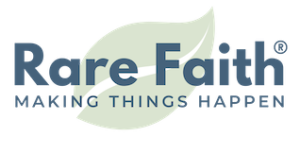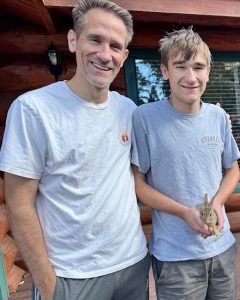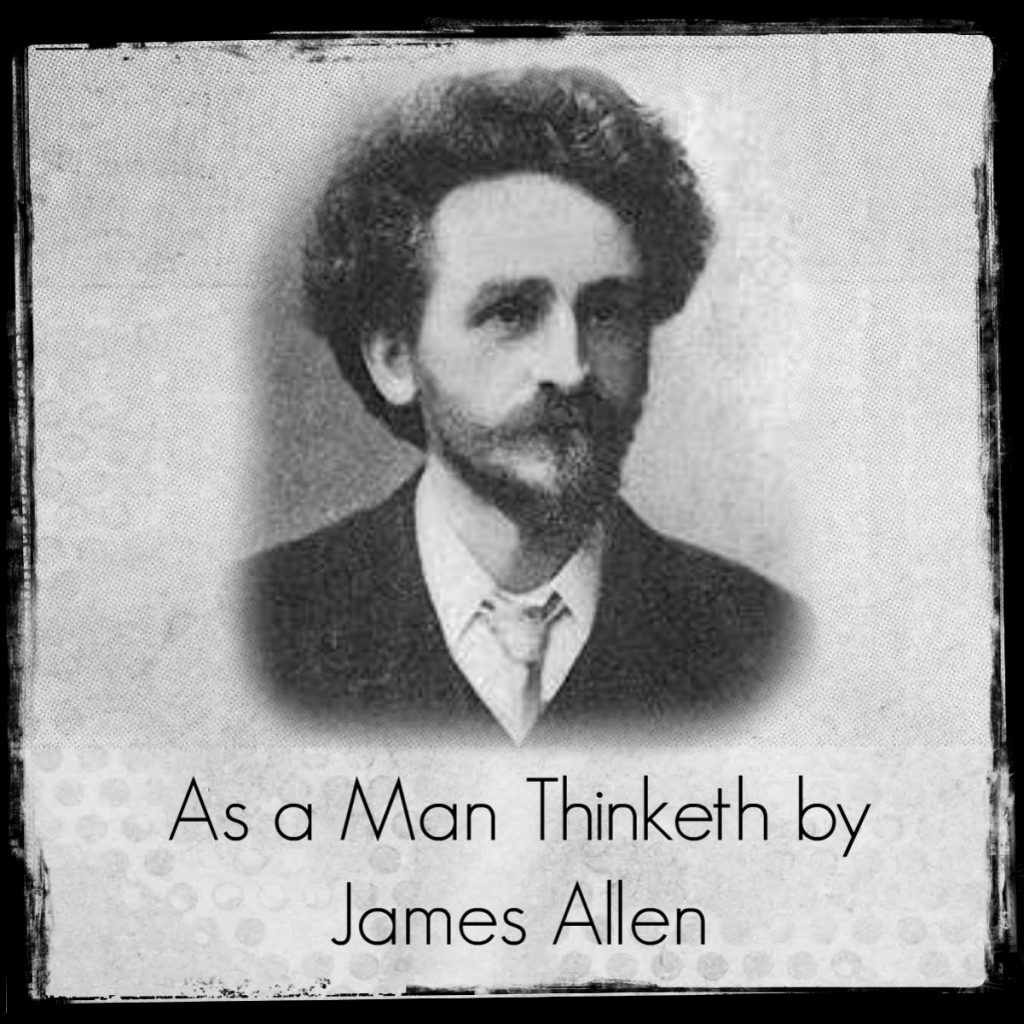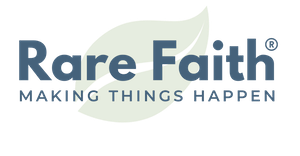In this podcast episode, I talk with Dr. Paul Jenkins, the “shrink who expands your life”. We discuss how to live and think so that the kind of serendipitous encounters you need to achieve your goals become common and expected.
When change is hard, it’s easy to get stuck. In this program, you’ll get a fresh perspective that will help you believe in the impossible, and find courage to step into freedom. Once you understand what the fear really is, it no longer holds you.
Just because you’re comfortable with certain aspects of your life, it doesn’t mean they are right. How do you see yourself subconsciously, and why does it matter? Learn how the acorn analogy helps you have more peace of mind and confidence right now, no matter what.
Learn more about Dr. Paul at www.drpauljenkins.com. Learn more about Leslie’s 12-week home study program at www.prosperthefamily.com
TRANSCRIPT
ANNOUNCER: Welcome to the Rare Faith Podcast, where the solution to every problem is only an idea way; where the same activity with just a little more awareness always yields better results. Award-winning, best-selling author Leslie Householder brings some of her best information to this inspiring series of life-changing episodes that you won’t want to miss. Show notes for this episode can be found at ARareKindofFaith.com.
DR PAUL: This is Doctor Paul, The Shrink Who Expands Your Life. I’m excited to be here again today. I want to immediately introduce my guest for today’s show. This is Leslie Householder. Leslie say, “hello.”
LESLIE: Hello.
DR PAUL: Glad to have you with me. Leslie is here by way of telephone today – she’s not sitting in the studio with me – but Leslie I sure appreciate your agreeing to be on the show today. I think most of our listeners are already going to be familiar with you, Leslie, because I’ve quoted you a number of times
LESLIE: Okay.
DR PAUL: So hopefully they’re listening. Probably the place they would know you best is from a best-selling book called The Jackrabbit Factor which you came out with – how long ago? I’m not even sure.
LESLIE: About two years.
DR PAUL: It’s been about two years…
LESLIE: It’s been about two years, yeah.
DR PAUL: …and this, just, phenomenal book, I think, introduces a number of principles in a story format that makes it so accessible to people; and Leslie I just want to thank you right up front for creating this, which I know has blessed the lives of a lot of people and will continue to do so as the word spreads around about The Jackrabbit Factor, what it means, and how you can apply it in your life. So that’s the initial introduction I’m going to give for you. What I would like to do here during this first segment of the show is give you a chance to, to introduce yourself a little bit, too – one of the things that I hope the listeners come away with today is just a sense of who you are. Just because your name’s on a book doesn’t mean that you’re this unapproachable, you know, sort of out-there kind of a person, because my experience with you has been that you are just this genuine, real person who’s having some experiences in life that you’ve been willing to share.
LESLIE: I have to say that the funny thing about this is I never set out to be a writer. I heard somebody quote – oh gosh I don’t know who it was – somebody had asked a famous musician, “why do you write music?” and he was just like, “so I can sleep!” you know? And I felt in the way that once I was turned on to these ideas and I saw them make such a huge difference in my life I couldn’t not. I wrote it so I could sleep and it was quite a ride putting that together.
DR PAUL: Oh. Could you just share a little bit about your story? I’ve heard you talk about this before and I know on your website – which, incidentally, let’s give a plug for that right up front, then we’ll come back to that in the last segment of the show – but ThoughtsAlive.com is the website where people can get connected with you and sort of read through your story, and also get access to some of the things that you’re providing and offering in terms of coaching and access to some materials that get people connected with principals. So I want to give a plug for that.
LESLIE: Well, I appreciate that. You know most people can’t hear when I say ThoughtsAlive they think I’m saying, “spots alive” or something else, so if you can’t make sense out of that, it’s “thoughts,” as in “thinking.”
DR PAUL: T-H-O-U-G-H-T-S
LESLIE: And if you can’t remember that, JackrabbitFactor.com will get you there too, so, easy way to remember.
DR PAUL: Well let’s, let’s have you just give a brief synopsis of your story. Where did this come from, where did you come from? Who are you, anyway?
LESLIE: Okay, well, I was born at a very young age.
DR PAUL: I love that.
LESLIE: It’s funny, because when, when my husband and I married in 1991, all I wanted was to be mom. That’s, that was my dream since I was a kid and, just looked forward to filling that role, and when we married we had agreed that that would be what he wanted for his children was for me to be at home, and I wanted that for, for them as well, and we weren’t financially prepared to do that when we married but we just believed that’s the right thing to do for us therefore there will be a way; and when the first baby started to come along a year later, he was born and that was it: it was for me to be mom, so I quit work, and before I quit work we were making about $1,200 a month. Now this wasn’t in, it was not in the 1950s, you know?
DR PAUL: This was before you quit?
LESLIE: Before we quit we were making 1,200 and…
DR PAUL: Oh boy.
LESLIE: Yeah, yeah. But we knew there’d be a way, you know? We, we just believed there’d be a way, and a year later things had fallen so far that when my husband had a job layoff or whatever it forced me back to work. I mean, I should have been back at work anyway just because we weren’t prepared to do that, but it forced me; there was no choice, you know, at that point. I remember dropping my little boy off at daycare early in the morning when it was still dark outside and spending all day at data-entry you know, somewhere – and then coming home and picking him up on the way home while it was dark at night. And come home, get some dinner, put him to bed, and it was just ripping me apart inside just because this was so contrary to what my dream for my life had looked like. And we both recognized that, you know what? There’s got to be something about the way we think that is keeping us from moving forward, and that’s when we started attending seminars. Some friends of ours that were doing better than us had said that the seminars could really do us a lot of good. What they were really saying is, “you guys have stinking thinking and you need some input to help you grow and…”
DR PAUL: They gave you some loving feedback, did they?
LESLIE: Oh, you know. But we started going and literally, over the next not even a decade, we attended more than a hundred seminars. They weren’t expensive: ones that, you know, $20 here or there that each time was a real stretch for us. It was a real, “oh, can we afford a babysitter for another seminar? Oh, where’s the grocery money coming from? Oh…” – you know?” But we were so empowered by everything we learned along the way that it kept us going. Until, after about seven years of it I had plummeted into a depression that was so deep, I mean at one point – and so many of you have already heard this story, but I say it every time to give you a feel for where I was at – I called the police on the neighbor kid who broke my broom.
DR PAUL: Yeah, that’s right.
LESLIE: And you have to be in a pretty bad place to think that that’s the only way you can solve that problem.
DR PAUL: Yeah.
LESLIE: You know?
DR PAUL: Just the desperation that you must have felt.
LESLIE: It’s desperation. It was just, “when will this ever end? Is there an end? I can’t cope anymore!” And then, you know, another seminar is coming along. I’m like, you know, “I can’t justify putting any more on a credit card to go to a seminar when seven years of this hasn’t done much,” you know? It’s kept us from killing ourselves, maybe. It’s kept us from throwing in the towel completely, but…
DR PAUL: It was kind of the cheerleader approach wasn’t it? The, “rah-rah,” you know, “you can do it?” Mm-hmm.
LESLIE: Yeah, interspersed in there were some good principles like, “think big; picture what you want,” but you know I wasn’t, I wasn’t making any kind of connection that made a difference. So, at this place where I had called the cops on the kid who broke my broom, I actually checked out – I went to bed. And, actually I was looking through my journals yesterday and just to try to remember how long I had done that, and I was sleeping for about three days. I’d get up to just do what needed to be done but pretty much I’d just sleep. Sleep, sleep, sleep; I couldn’t face the world and I thought, “you know what? They’ve been telling me for seven years, ‘picture what you want; dream big,’” and I thought, “fine, I will. I’m out of here.” I did it to spite them. All the seminar speakers who were living the life I wanted and profiting from all my ticket purchases.
DR PAUL: All the fees you were paying.
LESLIE: I was bitter, yeah, and what I didn’t realize is that, that day that I really started to try to live the dream in my head as though it were true, I think, I internalized it and I felt it like it was real. I pictured the home I wanted to be in, I pictured what life would look like, and I wasn’t doing it to try to make anything happen – I was just trying to find some joy.
DR PAUL: Mm hm.
LESLIE: And I didn’t know that what I had done that day was really the beginning of major transformation. A year later we were living what I had pictured, and it wasn’t for two more years and a few more seminars that it dawned on me that what I had done that day had made a real difference.
DR PAUL: So you didn’t even really make the connection between your thinking change and the different results that you started to see in your life? At that point, you hadn’t made that connection?
LESLIE: No not for another two years or so, because life got better. We were in a home of our own for the first time. We were paying our bills a little better, but in time we ended up in the same kind of rut, just at a higher level. Same desperation, same frustration, just with bigger money.
DR PAUL: So, same problems, different price tag?
LESLIE: Exactly, exactly, and so, along comes another seminar; we were still going to them all the time. Another one comes along, and I said, “you know what honey? This is the last one I’m going to. After this I cannot justify it anymore. I’m just going to have to learn how to be happy the way things are because I’m done. I’m done.” And we went to this one and the guest speaker that was brought in taught us some things that just absolutely dumbfounded us. We looked at each other, our mouths dropped open like, “that’s all it is?” and all of a sudden everything we’d ever learned gelled into one simple beautiful package of truth. We came home from that event and three months later we more than doubled our income. Within three months. Almost tripled – well it was tripled but I try to speak conservatively. With that breakthrough that we’d waited so long for I couldn’t sit still. About six months later the company who had presented this said, “have you ever thought about teaching what you’ve learned?” I’m like, “I’m all over that.” It said certify to train and facilitate their programs was going to cost about nine thousand dollars but at the time what did we have in the bank from savings for the first time was nine thousand dollars? I thought, “well how did they know? How did they know we’d have nine thousand dollars?” So we did that. I trained to teach the material, but you know I have seven children; I still just want to be mom tell you the truth. I’d rather be mom than teach seminars but like I told you I just feel like I have an obligation and a duty to share what we’ve learned, so I wrote Jackrabbit Factor to be the portable seminar. I did some and thought, “this is really time consuming. If I just write a book maybe that can do the work for me while I’m changing the diapers at home,” but then it came out and it was a best-seller and it created a new demand for seminars, and I said, “well, that [unintelligible]”
DR PAUL: Right. Then more people wanted your time.
LESLIE: Yeah. But it’s exciting to see change, see change in people.
DR PAUL: And what you’re saying is so true: when you catch a principal in a way that creates freedom in your life, the first thing you want to do is go out there and share it, and share it in a big way. I’ve heard that story before and, you know, every time I hear you talk about this I feel inspired, and the reason I feel inspired is because I feel kind of like a normal person, you know? I don’t see myself as one of these hugely successful people that everybody looks up – although you know I get interesting feedback about that because I’m, I’m Dr. Paul, The Shrink Who Expands Your Life.
LESLIE: I love that, by the way.
DR PAUL: Well, thank you. But you know, I’m just a normal person; you’re just a normal person who’s discovered some principles, and as you were telling your story, you know: you had this powerful experience at the very last seminar you were ever going to attend.
LESLIE: Which wasn’t my last, of course.
DR PAUL: No, but you didn’t know you’d be at the front of the room at some of the next ones, huh? What, what was it? What was it for you that clicked, and this may be a hard thing to summarize in just a few minutes.
LESLIE: It is tough to summarize and there’s so many different facets of it that had to come together for me all at once, but one of the things that was a huge “aha” for me was to realize that I, as a person, am a bundle of energy. I mean, everything in the world vibrates. The table in front of me is solid as can be but on a molecular level, it’s atoms and molecules bumping around, you know? It’s an ocean of motion, and I am also full of that, and have you ever come into a room where someone is upset and they might not even be turned your direction but you can walk into the room and you just feel that there’s something wrong, you know what I’m talking about?
DR PAUL: Well, we talked about that, you know, getting bad vibes.
LESLIE: Yeah, yeah and you know, you, you can try to hide what you’re feeling and that’s all that, you know, the Law of Vibration is about – the Law of Attractions, the Law of Vibration – is, is feeling, is nothing more than a conscious awareness of a particular vibration, so it’s nothing real woo-woo out there; it’s just a matter of how you feel. So, if I’m feeling horrible and someone comes in and says, ”ooh, what’s wrong,” and I say, “nothing,” well, baloney! The dog knows something’s wrong, and I became consciously aware that how I think and what I’m feeling is putting off a sort of energy or vibration that others will pick up on on a subconscious level, if no other way, and the reactions that I get from people and the opportunities that show up are going to be in harmony with how I think and feel most dominantly. And the reason this helped me so much is because when I was going to all those seminars I had certain business goals in mind. We had family goals; we had income goals and this kind of thing, and when the speakers would say, “dream big; get excited; picture what you want, you know; choose a goal that’s bigger than the obstacle,” all these, all these clichés and things, I thought that they were trying to get me excited enough to do superhuman things. You know, because when you’ve got the adrenaline and you can do superhuman things, that’s when things happen, but what I realized is that that’s not why we are supposed to dream big or picture what we want. The reason we do it is not to get ourselves psyched up to do something superhuman and amazing, it’s so that we can change our vibration on a molecular level and be tuned in to the very solution, the very ideas, the very people, resources, opportunities, whatever it is, that we need to accomplish those goals. When our mindset is focused on those things in an optimistic mindset, then those opportunities, resources, people – everything – just starts to show up in your life in a very natural way, in serendipitous ways. And so, instead of overcoming obstacles with superhuman adrenaline, you know, heat, what it was was realizing that as long as I am in a mindset of belief then the thing I want is approaching me just as rapidly, and so instead of going the distance – to reach the goal you’ve got to go the distance – instead of that, I realized I only have to go halfway. It meets me in the middle. Oh, and that was huge; that was huge.
DR PAUL: It’s coming toward you, right.
LESLIE: It’s coming towards me as long as I’m moving towards it, and to realize that, it just took a lot of pressure off of me because I realized that, you know, I have this goal, and when I’m not working on it – say I decide to take a lunch break – it used to be that if I take a break then nothing is happening, whereas now I know that even if I take a break it’s still approaching me, because I have not rooted out the idea seed – I haven’t rejected it yet. I still believe it’s on its way therefore it’s still in process, and progress is happening whether I’m on the phone or not. Whether I’m doing this work or that work or not. So, it gave me a lot of peace to know that I could sit still, I could take time to think, I could take time to enjoy my family; I could do these things and know that my objective is still in process moving towards me. And that made a huge difference.
DR PAUL: That’s a powerful concept. I’ve heard it taught really well by a friend of mine named Steve D’Annunzio, and he wrote a book called The Prosperity Paradigm. In fact, Steve’s going to be doing one of these podcast episodes with me in the near future, and the example that he used – it’s a principle called sympathetic resonance – and this is something that comes from the world of physics – where the example he uses is a tuning fork, and if you start a tuning fork vibrating and then you run that tuning fork along in front of the strings of a harp – and not touching them but just, you know, near them – when you get to the string that has the same frequency as the tuning fork, it will start to vibrate along with the tuning fork, because it’s on the same frequency. Now, the ones that are higher or lower don’t seem to be affected at all by this tuning fork and so what you’re saying is, this is a natural law that works not only in physics but in other aspects of our life too, because in the end, you know, physics applies to all things.
LESLIE: It’s true. It’s true, and so I teach people to get in tune with the goal that they’re trying to accomplish. As James Allen says in his book, As a Man Thinketh, “men do not attract that which they want but that which they are.” You know, we…
DR PAUL: Yes.
LESLIE: We have to – you know, have you ever been someplace that you just completely feel uncomfortable there?
DR PAUL: Oh, yeah.
LESLIE: Maybe, maybe it’s a scary part of town, or maybe it’s a very wealthy part of town. Whatever is different than who you are is not going to feel comfortable; and so, in order to change our life, we have to become comfortable on a subconscious level with the kind of life we want to be one with, and we do that by daydreaming about it, by putting ourselves in experiences and places where we can try it on, you know? People wish to be in a different place, but in reality, if they were to go there right now they wouldn’t stay long, because they’re not yet at peace with it on a subconscious level, and we change those images in our subconscious mind through allowing ourselves to picture ourselves in it, and generate the feelings that we expect to feel. I mean, imagine – we just have to ask ourselves, “what would it be like if…?” If you can answer that question – and, and you can start some real powerful thoughts just by answering that question in your mind, you know, in a quiet place – “what would it be like if…?” “What would that feel like; how would that feel?” And when you can accomplish that, when you can take the time to really experience it and feel it as though it were really true, you have just altered your vibration on a molecular level just like the tuning fork and the harp. You have changed the frequency of the energy that you are putting off and it’s the difference between – supposing you’re in an elevator with a person. You’re either going to strike up a conversation with that person or they were with you, or not. Whether it happens or not has everything to do with who you are and where you’re headed, and who they are and where they’re headed. Either there will be resonance and a reason on a subconscious level to say, “hey,” or it won’t, and literally everything that we need to accomplish what we want to accomplish is right within our immediate surroundings – the beginnings of it are right here, right now. I like to think of it like an acorn. An acorn is, has a blueprint for a great oak tree within it, and yet, in your hand is it in a state of decay or growth?
DR PAUL: Mm-hmm, and that depends, that depends on the, the context in which you place the seed, and place it in one that nurtures its growth or that just allows it to die.
LESLIE: Well, and in our hand the acorn won’t become an oak tree. In the ground where it belongs it will gather to itself everything it needs, and in fact it doesn’t have to race around looking for bark molecules and leaf particles; it only holds itself still and its very being begins to make connections with its most immediate surroundings. There’s a particle touching it that it needs, so there’s a bond that’s formed because it carries within itself a blueprint for what it’s going to become. We’re the same way. An idea is a seed. We hold it in our mind; that’s where it is nourished, that’s where it can grow, and it puts us, kind of like that seed, into a state of being that starts to make connections in our immediate surroundings that will lead us to everything we need to accomplish our ultimate design.
DR PAUL: And that’s because it already exists, right now, in some form. And, I’ve thought about this quite a bit, Leslie, that, that matter can’t be created or destroyed: it already exists somewhere in some form and it’s waiting for – you use the word blueprint, you know – the form or the pattern to, to call it together in a way that is meaningful, and it will always resonate with whatever frequencies or energies are being applied to it. And then also, I wanted to talk a little bit about this idea. You introduced a question, and I think this is a very useful question. I want to have everybody just put this in your toolbox right now. The question is, “what would it be like if…?” Or, “what would I feel like, what would it feel like if,” you know, that thing that you want to create is already there?
LESLIE: Yeah.
DR PAUL: And the reason why I feel that is so important – this is coming from some of my background as a psychologist – and as I’ve studied the mind and just how people think and how things kind of click together, the subconscious operates largely in the language of emotion. Any experience you have that carries with it a strong emotional component is going to be seated very deeply into your subconscious mind, and then it’s your subconscious that’s really driving. It’s got its hands on the steering wheel, so to speak, and is creating the results in your life. So, this is both good and bad news, because, as you figure out what it is that you want in your life, and become clear about that image and then attach an emotion to it and start to imagine and picture and feel what that is like, it drives it into your subconscious. But on the flip side of that, what if you have a strong negative emotional reaction to something you DON’T want in your life; whether it’s, “I’m overweight,” and then you suddenly have this emotional reaction to that thought?
LESLIE: Yeah.
DR PAUL: Or, “oh my gosh, we’re in debt!” And you have a strong emotional reaction to that thought.
LESLIE: Yeah.
DR PAUL: It’s creating the same process, would you agree?
LESLIE: Yes, but I do want to say something on that. Once I learned this, these principles, and when I’d go through a time where I was really struggling, or I might be trying to make a change and I’m trapped with these doubtful negative emotions and then knowing that, “oh now I’m blowing it,” and then it just gets worse and you go through this downward spiral, I, I discovered that there is hope, even when, even when we’re in this negative cycle of downward thinking, and what that is is knowing, “okay so I’ve got a goal in mind.” Maybe it’s a weight goal, maybe I have in mind how I want to be with my health for example, and I’ve set a goal about that; and then one day, family’s over and they’re bringing all the treats and you indulge, and you just eat until you hurt – I do that sometimes – and then you come away thinking, “oh man I just blew my goal! Oh, oh, I hate being the way I am;” go through this negative cycle. At that point, right then and there, you have a choice. Now if you remember, before I said, “as long as you believe, the goal is continuing to develop and will be accomplished as long as you don’t kick it out.” Now at that moment, most people kick it out because they think, “oh I blew it.”
DR PAUL: That’s right.
LESLIE: But what I found is that, when I’m having an off day or an off week or an off month, whatever it might be, and I’m depressed or whatever, because we go through these cycles no matter how much we know, we will be challenged – there are challenges to stretch us and grow us because this whole life is a process of growth, and unless you’ve got struggles to overcome there is no growth, so we have to get okay with that – but if I’m in a place where I’m not doing well with this, I think, “oh okay, I’m not doing so well at that.” It’s okay; the goal is still on its way because I’m just in one of those ebb days; there’s ebb and flow, I’m in an ebb day, therefore a flow day is coming, and I start thinking, “how is that going to feel?” And look what I’ve done; I’ve just made a choice. I’ve made a choice, and so it only defeats us if we allow it to defeat us. It’s only sabotaging us if we choose to believe that it has sabotaged us. When I’m having an off day, you know what else sometimes I think? I think, “I don’t know if I can do this, but imagine how much more I’ll be able to relate with other people who go through this on the other side of it. This is good for me,” and I turn it. I’m not always perfect at this you know, but I, I know that as long as I don’t give up – what is the Chinese proverb that says, “fall down seven times, get up eight?”
DR PAUL: Yeah.
LESLIE: It’s when a person says, “oh I’m thinking negatively, therefore this isn’t gonna work for me. I just blew it, it’s over; darn!” That’s when it does get blown. It’s when the person thinks negatively and says, “I didn’t do so hot at that, but I still think it’s on its way and I’m going to take an action even though I don’t feel like it.” Like, sometimes there’s something that I need to do with my business to help share this message, and I might be in a day where I don’t feel like doing it; maybe I’m, maybe I’ve had an upset with one of my kids, or maybe I’m in a bad mood, and yet right there I can say, “oh, I better call up and cancel my commitment because I’m not in the right place,” or I can say, “all right God, use me. I will show up. I’m turning this over to you; use me as you will. Just use me. You know, I’m willing.” When we take an action in spite of our feeling, then we have taken control.
DR PAUL: I’ve often thought just how, how amazing it is what God can do with a rusty tool, you know? And that’s just one way to look at it. As you were talking about this process of, of not throwing it out – one of the phrases I like actually comes from the scriptures and it says, “don’t cast it out by your unbelief.”
LESLIE: Right.
DR PAUL: You know, and there’s one that says, “doubt not because you see not.”
LESLIE: How many seeds have you planted that didn’t show up as a sprout for some time?
DR PAUL: Mm-hm.
LESLIE: And how many seeds have you ever planted that you didn’t water for a week and it didn’t die?
DR PAUL: Mm-hm; that’s right.
LESLIE: You know, nature handles things. It – some seeds take some real effort to kill, and so if we choose to believe in our dream strong enough, then a bad day, a bad week, isn’t going to kill it, and as long as we believe that it’s still there and still growing, it is. When we give up on it completely and go dig it up and throw it away, that’s a whole different story.
DR PAUL: Leslie, you said something about an example you wanted to share. Have we already touched on that, or is that something you’d still like to present?
LESLIE: Well, we were talking about how when you have changed your mindset, your vibration is different, you’ve tuned into different opportunities and resources and whatnot, and it’s like a radio, it’s -we are like a radio, if we need ideas that, you know, we have a problem and we can’t think of a solution to it, it’s just because we’re on the wrong frequency and we can adjust our tool; we can adjust ourselves by choosing thoughts that generate feelings that are in harmony with the thing we’re looking for. So, here’s an example: I was in the middle of writing The Jackrabbit Factor and I thought, “wouldn’t it be cool if it were a best-seller? What would it feel like if…?” And I thought, “okay, that one’s way out there!” I did write it down; I had written a goal statement for my short-term future, and in the middle of that I said, “I am a best-selling author,” and I didn’t believe it. I mean, it was the most outlandish part of my goal statement that I could have come up with, but I wrote it a couple times; I said, “I am a best- selling author, I am a best-selling author, I am a best-selling author.” I had to write it a lot because I knew that if it’s hard to believe, repetition overcomes that. You tell yourself a lie often enough and you’ll start to believe it, you know? So, I was reading this every day; I was reading this every day, and that’s one thing – some people – you know, you try to picture what you want, and you just can’t feel it; it’s so outlandish you just can’t feel it. Well, you say it as though it’s true, enough, and you’ll start to believe it on a subconscious level, and that’s what I had to do. So, a month after doing this I get a phone call – or an email; my website was just brand new – just a baby of a thing – and somebody emailed me saying, “I just read your Hidden Treasures” – this was a Jewish man from New York – and he says, “I just read your Hidden Treasures and you know what? I think you’ve got a best-seller here.” And I say, “well yeah.” You know, I was focusing on Jackrabbit Factor at the time and that’s the one that I’m really going to promote just because it’s the introduction. Hidden Treasures is a little deeper and it’s got to be better to focus on the introduction to get it out there, and I said, “well you know, I’m working on this other one,“ and he said, “well, alright. Would you be interested in helping us launch Jack Canfield’s Success Principles book? We’ve got a team that’s working on getting his message out now that it’s a new book and everything,” and I said, “well, sure, sign me up.” So, I became part of that team to help launch Jack Canfield’s Success Principles book, and I saw how they created a best-seller and I thought, “well, that’s not that hard; I can do that!”
DR PAUL: I can do that!
LESLIE: So, I just duplicated what I saw them do, and Jackrabbit Factor became a best-seller; and so, I’m wondering, “what did I do to get that email?” I changed my vibration. I changed the core inner picture that I had been holding in my mind. I got to where I could almost start to believe it; I thought, “you know what? Maybe it could happen,” and just shortly after that he sends me an email saying, “let me show you how to be a best seller.” I didn’t go looking for that; it found me, and that’s these serendipitous encounters that I, you know, that I was mentioning before. You change you and stuff happens.
DR PAUL: Well the radio doesn’t go out there and find a signal. The signals are already there, and as you, as you tune in to them and get your frequency calibrated to the frequency of the signal then you make that connection.
LESLIE: Exactly. And every…
DR PAUL: And, Leslie…
LESLIE: Yeah, go ahead.
DR PAUL: Oh, I was just gonna say, you said, you know, you tell yourself a lie long enough you’ll start to believe it. You can tell yourself the TRUTH long enough that you’ll start to believe it.
LESLIE: Including, “life is abundant; there is more than enough.”
DR PAUL: And you are…
LESLIE: “I am a money magnet.”
DR PAUL: You are, in fact, a best-selling author; that is the truth. Now, you were lying to yourself before about that, and when you started saying what felt like a lie to you, that was actually the truth, and you were telling the truth in advance.
LESLIE: Exactly.
DR PAUL: Stick with us, we’ve got one more segment, folks, with Leslie Householder. Okay, as we’re wrapping up this show I find myself wishing, Leslie, that we had a two-hour show today.
LESLIE: I know.
DR PAUL: Or, three or four or something like that. But you know what, we’re just getting started on some things. I’m hoping that you listeners are feeling something here, because as we discuss principles of prosperity and success and happiness, I have found as I share those things with people that they really resonate to it and they, they develop a thirst for it and, Leslie, you’ve been in the position where you were a seminar junkie, you know, because it calls to you, and there’s something in the human spirit and in the human soul that says, “I hope it’s possible. I want it to be possible,” and, Leslie, your story is so inspiring because you found that it is possible and it’s not as complicated as you might have thought.
LESLIE: Right.
DR PAUL: I want to hit one more topic just for a few minutes here, and we probably can’t do it justice, but there’s this thing called the terror barrier.
LESLIE: Yes.
DR PAUL: And I’ve heard you talk about this, and Bob Proctor, and there are different ways that different teachers approach the same principle. Can you give us, just, maybe a two- to three-minute overview of what that is?
LESLIE: Yes, in fact, this was the part of that event that my husband I looked at each other and said, “that’s what it is.” So, this was the piece that facilitated our breakthrough, and so it’s hugely important. On a subconscious level, our beliefs about ourselves and what we’re worthy of and, and all these things; our outer conditions – the way our life looks right now – is in harmony with who we are on a subconscious level, and we might be screaming, “I hate this! I can’t stand this! This is not right,” but deep down, it’s where we’re comfortable; it’s what we know. It’s how we see ourselves subconsciously. It’s our conscious mind that does all the fussing and throwing tantrums. So, once you decide, “I want something to be a little different,” and we start to daydream – I have a, an illustration of this called “The Stickman.” There’s a video on my site you look for “The Stickman” video, that’s ThoughtsAlive.com, and you can see a whole hour presentation on it for free. But basically, say you have an X idea in the subconscious mind, X meaning it represents something for you; it might be, “there is never enough money,” so that’s the X idea. Well, when we get dreaming and we create a new idea, say we want it to be Y instead, we have Y in our conscious mind, and once we add emotion to it by seeing it as though it’s real and feeling it and experiencing it and asking that question, ”what would it be like if…” then we have planted that idea on a subconscious level and began to let that seed grow. Well, along comes an opportunity that is in harmony with the new idea; something that’s going to help you reach that goal of the Y idea, meaning, “life is abundant; I have all I need,” – a new way of thinking. So, an opportunity comes along, and we go to take action on that new idea, because subconsciously it’s in harmony with us. But the old X idea has never gone away; it’s still in there, and the thing about the subconscious mind is that it cannot accept or reject or discern truth from falsehood – it accepts everything to be true in these terms, and so it’s believing there’s never enough money and now it’s also believing life is abundant. Well, those do not correspond with each other; they’re not in harmony with each other, but on a subconscious level you’ve accepted both of them. So, you go to take action and this fear grips you, and what I learned was that the fear was the physical manifestation of two ideas in your subconscious mind that are in conflict. That’s all it is – two ideas in conflict. It leads to the fear; and once we realized that the fear meant that the new idea had taken root, and that the results were only that close if we would just take action on it, it gave us the courage to break through that terror barrier – that wall of fear – and you know, most of the time people feel that fear and they think. “ooh, this must be wrong.”
DR PAUL: That’s right.
LESLIE: “Ooh, this opportunity is bad,” and that fear keeps them from moving forward. Well, when we realized that that fear is simply a manifestation of two vibrations that are in conflict, like they’re discordant, discordant in the subconscious mind, it manifests itself as anxiety; fear; dis-ease in our body.
DR PAUL: Mm-hmm.
LESLIE: So, you know, that was huge; just understanding what that was gave us the courage to do and take action on the opportunity that showed up for us, and after three months our income skyrocketed the way it did, because the fear didn’t hold us back for the first time ever.
DR PAUL: So this is really great news, Leslie. When you feel the fear…
LESLIE: Yes, it’s a good thing.
DR PAUL: Here you are, you’re at a choice point, right?
LESLIE: Exactly.
DR PAUL: And at that point you can step forward into the new world; the new idea of freedom, prosperity, this Y idea that you’re talking about. That’ll make more sense, folks, if you go listen to the presentation on the website – the “Stickman” presentation – and I use this to teach people, as well, because it’s such a powerful concept. And the alternative, rather than stepping forward into freedom and prosperity, is to retreat back to the X idea, which is secure; that represents security.
LESLIE: Yeah.
DR PAUL: Or at least perceived security, because it’s what your subconscious is already used to, and just because you’re used to it does not mean that you’re right; just means that you’re used to it.
LESLIE: You know, and that Stickman concept was developed in the 1930s. Been around a long time, and, it has been instrumental in helping therapists make greater progress in 1, 2, 3, 4 sessions with a person than they’ve ever made in four years with that person. It’s powerful. It’s, it’s a way of shortening the process of change, and, again, you can see a whole demonstration, illustration, you got, visually, it’s everything on that free video.
DR PAUL: Well, you know Leslie, one of the seminars that I present is called, “Your Brain: The Owner’s Manual,” and there’s a little difference between your brain and your mind, but I like to teach people how their brain works and how their mind works. It’s kind of like an owner’s manual, you know, you go out and you buy a power tool, and it would be really cool if you knew how to run the darn thing.
LESLIE: Yeah.
DR PAUL: And so you get the owner’s manual, and you, you figure out how to operate it safely and effectively and, and then it can be a great tool for you. If you don’t understand how it runs or how to run it, it becomes dangerous and you can actually create more destruction in your life. You know, I think your mind is very similar, and this has been a powerful concept to help people understand that. We’ve got just a few minutes left and I want to make sure that we put in a plug for something that I personally have found to be very valuable. My wife and I have a copy of your home-study course, and I’ve heard you talk about this too, because, I know you want to be home with your family – that’s where your heart is – and so instead of going on the road and doing all these three-day seminars, what you’ve done is put it into a box, and it consists of some DVDs, there’s a journal in there; there’s a huge workbook – Leslie that thing is a monster – with all kinds of material in there. There is truly an abundance of resources in this home-study course. I wanted to invite you to just talk about that briefly: where you’re coming from with that to give people a flavor for it.
LESLIE: We have invested in countless programs over the years. We have literally spent more than a hundred and fifty thousand dollars on seminars, and programs, and things to understand this stuff, and fine-tune our understanding of it, and get to a place where we can teach it as effectively as possible. Because, you don’t want a program that is just an outline of, “this is what you need to do: bam, bam, bam,” as if we could learn something from a list of bullet points. That’s all good, but what my objective is, my intention, and that was my intention for The Jackrabbit Factor book as well, is to not just tell you what you need to do so that when you’re done you have to go make yourself do it, but that the process would actually facilitate the change. That reading the book would facilitate that change in you. That going through this 12-week home-study program would bring you out on the other side a different person, with the thought habits that you want to accomplish the grand things that you were sent here to do.
DR PAUL: Mm-hmm.
LESLIE: And, that is the purpose of this program. It’s different than any other one I’ve ever seen on the market, and I guess I just approached it with the learning style that I wished I had been able to receive, to shave years off of my learning process, and so, you know, I, I wanted to shave years for people. I know others don’t have 15 years to learn what took us 15 years to learn. Others don’t have $150,000 to spend on the programs that we needed to get us where we’re at, and this is a way to get even more than I can do in a three-day seminar because, literally, it takes at least 21 days to change habits, and I’m going to help you do that.
DR PAUL: Oh, perfect! How do we get people pointed toward that? I know you’ve got an offer for our listeners to get connected with this.
LESLIE: Right. There is a website called ProsperYourFamily.com. ProsperYourFamily.com, and that is where you’ll see everything that it has, does, will do for you; see if my story – and I’ve got more of my story, I’ve got some journal entries from right before our breakthrough, so that you can really get a sense for where we were coming from, and maybe you’ll connect with it; maybe it will resonate with you. And I do that to connect with my readers so that they can believe that it can work for them, too. The front of The Jackrabbit Factor book says, “why you can,” and all three of those words, individually, should be emphasized: WHY you can; why YOU can; and why you CAN. In every sense of the word, so…
DR PAUL: Thank you so much for offering, I think that’s going to be an incredible value to a lot of our listeners, and thank you, especially, for taking some of your time to share this value with us today on this podcast.
LESLIE: I’ve enjoyed it; thanks for having me.
DR PAUL: Oh, this has been fantastic. I want to point everybody toward Leslie Householder, obviously, The Jackrabbit Factor, Hidden Treasures, some of the books that she’s written; and go to ProsperMyFamily.com, where you can get connected with a powerful home-study course that can help you to take these principles to another level. Go out there and live on purpose everyone!
ANNOUNCER: This concludes today’s episode of the Rare Faith Podcast. You’ve been listening to Leslie Householder, author of The Jackrabbit Factor, Portal To Genius and Hidden Treasures: Heaven’s Astonishing Help with Your Money Matters. All three books can be downloaded free at ARareKindofFaith.com. So, tell your friends, and join Leslie again next time as she goes even deeper into the principles that will help you change your life.


















Recent Comments